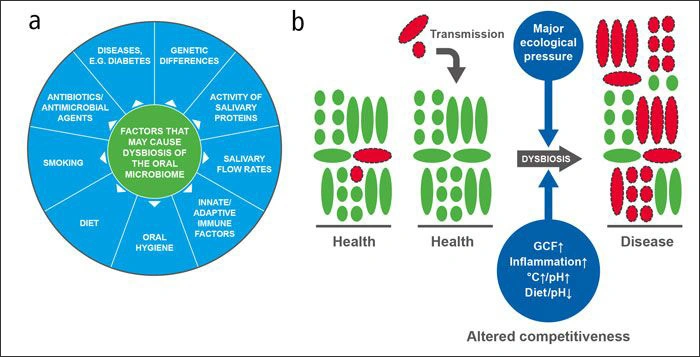The Oral Microbiome & Systemic Disease
Course Number: 561
Course Contents
Oral Homeostasis
Many may think that all bacteria and microbes are bad, however nothing could be further from the truth. There are thousands of microbes that are a necessary part of our body’s functioning, such as the digestive system as well as the body’s normal defense system, many of which produce antibacterial substances (bacteriocins) that serve to eliminate the pathogenic bacteria and work to restore homeostasis.18 When the body (including the mouth) is in a state of health, there is a balance of microbial species that live in a state of symbiosis, or harmony. While the makeup of the oral microbiome can be very dynamic in a healthy mouth, oral homeostasis can be easily maintained in generally healthy individuals with the right habits.14
It is also important for the teeth and associated tissues to be bathed in saliva. Saliva and gingival crevicular fluid (GCF) contain proteins and other substances important for immune regulation, lubrication and maintenance of the oral flora.19 Some of the substances include immunoglobulin A, lactoferrin and lysozyme which can directly or indirectly regulate the microbiome. While the mechanisms are not fully elucidated, it is well known that the resident flora can have pro and anti-inflammatory functions that work together to maintain oral homeostasis.20
For example, oral health is associated with low diversity of bacteria as opposed to greater diversity and richness in a disease state such as periodontal disease. In a healthy mouth, there is a delicate balance between indigenous commensals and putative pathogens that prevent disease from being initiated. The host produces several enzymes (mentioned above) and immunoglobulins (antibodies) that all serve to maintain symbiosis. However, in a case where there are environmental changes in diet (i.e., increase in refined carbohydrates), one may find that there is an increase in pathogens (e.g., Streptococcus mutans in caries). If there is no appropriate oral hygiene intervention by the host, over time one can have a shift in bacterial community that leads to dysbiosis and an accompanying disease state (Figure 3).
Figure 3. Shift from Symbiosis to Dysbiosis.21
It is equally as important for the oral microbiome to assist in maintaining oral homeostasis as disturbances to the oral flora can have consequences for oral and systemic disease. Disturbances in the balance of oral flora are referred to as dysbiosis. Primary colonizers like gram positive bacteria (e.g., Streptococci species) make up a predominant part of the oral flora and serve as important barriers and first line defense against pathogens (e.g., anaerobic gram-negative bacteria such as Porphyromonas gingivalis).22,23 Generally, the normal flora (i.e., a consortium of beneficial bacteria) in any body site acts like a barrier to the pathogens that seek to invade and disrupt the oral cavity in an attempt to cause disease (e.g., gingivitis, periodontitis and oral Candida infections).24


